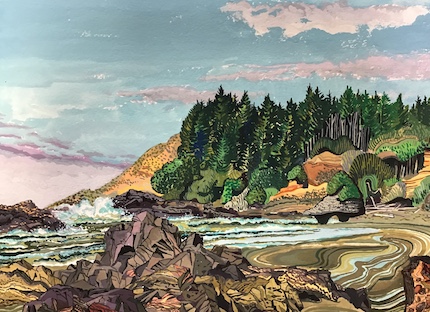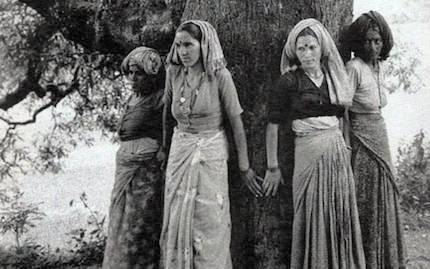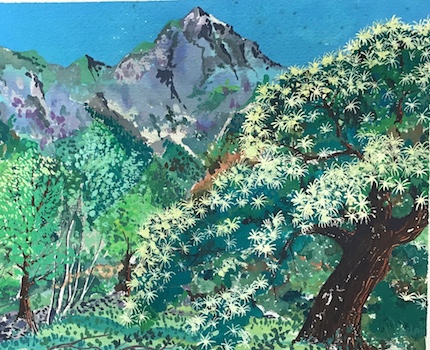|
KYSO Flash ™
Knock-Your-Socks-Off Art and Literature
|
|
|||
Trees Pleaseby Jack Cooper
When is the best time to plant a tree? Ten years ago. I’m in love with trees, and aren’t most of us, really? Few beings hold a more central place in our cultures and myths than trees. Adam and Eve ate from the Tree of Knowledge. Buddha meditated under the Bodhi Tree. Darwin constructed the Tree of Life. Dr. Seuss created an imaginary species called the Truffula Tree.3 I’d wager that not a single novel has been written without the word “tree,” that there is no artist who has never drawn one, that no inhabitant on earth can claim to be independent of them, even if, like the Inuit, they live north of the line where most plants stop growing. During the time I spent as a biology student in college, my childhood love of trees turned clinical: measuring photosynthesis, diagramming venation, examining xylem and phloem. Not until after I left graduate school, however, did I take it upon myself to become a lifetime advocate and steward of our tall, green friends. Since then, I have cared for existing trees in four states and three countries, and estimate that I’ve planted some 200 saplings—apple and apricot, fig and fir, pomegranate and ponderosa, a virtual arboreal alphabet. I also sponsored the planting of a California Live Oak in my mother’s name through Tree People and made several contributions to the Arbor Day Foundation,4 among others. While I’m proud of my tree legacy, Johnny Appleseed (born John Chapman), by comparison, probably planted and managed 100 times as many in his own nurseries across Ontario, Illinois, Indiana, Ohio, Pennsylvania, and present-day West Virginia. In Allen County, Indiana alone, he maintained four plots, including a nursery in Milan Township with 15,000 trees.5 One of his trees still lives to this day on a farm in Nova, Ohio, and its seeds and cuttings have been used to propagate hundreds of new ones over the years.6 A study led by Yale University researchers found that there are around three trillion trees on Earth, or just over 400 for each person on the planet.7 That may sound like a lot, but this figure represents less than half the total number of trees that had existed before the rise of humans.8 And more trees are being felled than ever before. Amazing new machines can move through a whole stand of mature hardwoods in minutes, cutting, stripping, and loading in one smooth operation. According to Conservation International, nearly half of the world’s rainforests have been cleared since the 1960s, and tropical forests are being destroyed at a rate of about 31,000 square miles a year—“an area equivalent in size to the state of South Carolina.”9
What a relief to learn that one young engineer refuses to take this news sitting down. Topher White of Rainforest Connection rigged up old cell-phone parts to listen for chainsaw noises in the jungles of Borneo in order to send signals on illegal logging to patrolling rangers. His idea has begun to spread around the world.11 Climate change has brought a different set of traumas to trees. According to Tree Hugger, bristlecone pines, gnarly antiquarians that have survived in an extreme environment for thousands of years, are now dying prematurely. The trees’ survival depends on the long winters and cool mountain climes of the eastern Sierras, now threatened by global warming.12 While higher temperatures have caused some trees to succumb to catastrophic fire, insect, and fungal damage, others are actually growing faster and taller, taking advantage of an extra three weeks of annual warmth on average. A recent study of the forests of Central Europe “suggests the higher temperatures—combined with pollution from auto exhaust and farms—are making wood weaker, resulting in trees that break more easily and lumber that is less durable.”13 Bucking the trend several years ago, Africa began creating a Great Green Wall 10 miles wide and 4,350 miles long across the center of the continent. “The desert is a spreading cancer,” said Abdoulaye Wade, Senegal’s president.14 The goal, to plant 11,000,000 acacia trees to reverse desertification, didn’t work at first. Too many trees were dying. After adopting “simple water harvesting techniques and protecting trees that emerged naturally on their farms,” the plan now seems to be working (Jim Morrison, writing for Smithsonian.com). Whereas multinational cooperation may be crucial to global reforestation, we shouldn’t discount the potential of more Johnny Appleseeds heeding the call. On an island in India’s Brahamputra River near the borders of Bhutan and Tibet, Jadav Payeng, “The Forest Man of India,” has spent 40 years planting tens of thousands of trees, says Julie McCarthy on NPR. Flooding over time had caused the buildup of sandbars, which choked the vegetation and left the land dry and treeless. But today, it’s teeming with greenery and wildlife. “The dense forest bearing his nickname, Molai, now sprawls over 1,300 acres,” McCarthy says. “Jadav Payeng has single-handedly changed the landscape....”15 Most recently, 1.5 million volunteers from the central Indian state of Madhya Pradesh set a new Guinness World Record in 2017 by planting more than 66 million tree saplings along the Narmada River in just 12 hours. The previous record had been set the year before by the Indian state of Uttar Pradesh, where 800,000 participants planted 50 million trees in one day.16 It could be that the trees themselves are helping these visionaries succeed. Forest ecologist Suzanne Simard gave a TED Talk a couple of years ago called “How trees talk to each other.”17 Simard, who has conducted research in the field for 30 years, believes that trees communicate among themselves as well as with other plants and animals around them—above ground with seeds and below ground with chemicals. Their “complex, symbiotic networks in our forests—at the hub of which stand what [Simard] calls the ‘mother trees’—mimic our own neural and social networks,”18 giving us one more reason to respect these collaborative living beings. Trees are emissaries between sky and earth, between breathing in and breathing out, between birth and death. They are color, shade, and sustenance. They are our history and our future. Trees make possible countless life forms, from bird to mushroom. They give people roasted chestnuts, fences, bridges, houses and, yes, crosses, and, yes, poetry.
Tree as metaphor takes a particularly interesting turn in William Blake’s famous poem “A Poison Tree,” from his 1794 volume Songs of Experience. The poem is commonly thought to be about the deadly consequences of repressed anger. A Poison Tree I was angry with my friend: And I watered it in fears, And it grew both day and night, And into my garden stole Even if Blake’s poison tree can be read as a warning about the dangers of emotional dishonesty, why is the poet “glad” to see his enemy dead? Wouldn’t he rather have a chance to root out this wrath from his heart? What if the poem were about healing? What if the foe, knowing that the beautiful apple belonged to the poet, took it as a sign of reconciliation, ate it with relish, and merely fell asleep under the apple tree, the proverbial Tree of Knowledge. Speaking of healing, the expression “An apple a day keeps the doctor away” obviously contains a seed of truth. Apples, like most fruits, are high in fiber, low in calories, and well supplied with potassium, calcium, and vitamin C.20 The Growing Air Foundation describes a couple of dozen reasons, beyond providing apples, that trees make life better on earth, from producing oxygen and absorbing carbon dioxide, preventing erosion, offering shade, and filtering rainwater, to providing food, medications, and wildlife habitat.21 Poisonous trees do exist, but their contributions didn’t make the list. Footnotes:
|
|
Site contains text, proprietary computer code, |
|
| ⚡ Many thanks for taking time to report broken links to: KYSOWebmaster [at] gmail [dot] com ⚡ | |


